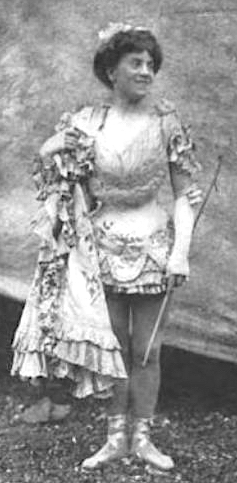
Embouchure or lipping is the use of the lips, facial muscles, tongue, and teeth in playing a wind instrument. This includes shaping the lips to the mouthpiece of a woodwind instrument or the mouthpiece of a brass instrument. The word is of French origin and is related to the root bouche, 'mouth'. Proper embouchure allows instrumentalists to play their instrument at its full range with a full, clear tone and without strain or damage to their muscles.
A crusher is a machine designed to reduce large rocks into smaller rocks, gravel, sand or rock dust.

Acrobatics is the performance of human feats of balance, agility, and motor coordination. Acrobatic skills are used in performing arts, sporting events, and martial arts. Extensive use of acrobatic skills are most often performed in acro dance, circus, gymnastics, and freerunning and to a lesser extent in other athletic activities including ballet, slacklining and diving. Although acrobatics is most commonly associated with human body performance, the term is used to describe other types of performance, such as aerobatics.

A trapeze is a short horizontal bar hung by ropes, metal straps, or chains, from a ceiling support. It is an aerial apparatus commonly found in circus performances. Trapeze acts may be static, spinning, swinging or flying, and may be performed solo, double, triple or as a group act.

A dentist, also known as a dental surgeon, is a health care professional who specializes in dentistry, the branch of medicine focused on the teeth, gums, and mouth. The dentist's supporting team aids in providing oral health services. The dental team includes dental assistants, dental hygienists, dental technicians, and sometimes dental therapists.
Cosmetic dentistry is generally used to refer to any dental work that improves the appearance of teeth, gums and/or bite. It primarily focuses on improvement in dental aesthetics in color, position, shape, size, alignment and overall smile appearance. Many dentists refer to themselves as "cosmetic dentists" regardless of their specific education, specialty, training, and experience in this field. This has been considered unethical with a predominant objective of marketing to patients. The American Dental Association does not recognize cosmetic dentistry as a formal specialty area of dentistry. However, there are still dentists that promote themselves as cosmetic dentists.

Deciduous teeth or primary teeth, also informally known as baby teeth, milk teeth, or temporary teeth, are the first set of teeth in the growth and development of humans and other diphyodonts, which include most mammals but not elephants, kangaroos, or manatees, which are polyphyodonts. Deciduous teeth develop during the embryonic stage of development and erupt during infancy. They are usually lost and replaced by permanent teeth, but in the absence of their permanent replacements, they can remain functional for many years into adulthood.

Siegmund Breitbart, also known popularly as Zishe or Sische Breitbart, was a Polish-born circus performer, vaudeville strongman and Jewish folklore hero. He was known as the "Strongest Man in the World" and Eisenkönig ("Ironking") during the 1920s.
The hair hang is an aerial circus act where performers are suspended by their hair, performing acrobatic poses and/or manipulation. Some believe the act originated in South America; others claim the act hails from China. Performers hang suspended by their hair, which is tied into a hairhang rig; the techniques used to tie the performer's hair and the acrobatic techniques involved in the act are key.

Static trapeze, also known as fixed trapeze, is a type of circus apparatus. In contrast to the other forms of trapeze, static trapeze the bars and ropes mainly stay in place.
The cloud swing is an aerial act that usually combines static and swinging trapeze skills, drops, holds and rebound lifts.

The Drill of Death is a large-scale stage illusion in which a performer appears to be impaled on a giant drill. It was created by magician André Kole and illusion designer Ken Whitaker for magician Melinda Saxe. It was one of Saxe's signature tricks and featured as a highlight in her various First Lady of Magic shows.

Leona Dare was an American trapeze artist and aerial acrobat, billed often as the "Queen of the Antilles" or the "Pride of Madrid". She was famous for her stunts on trapezes suspended from ascending balloons.

The Cyr wheel is an acrobatic apparatus that consists of a single large ring made of aluminum or steel with a diameter approximately 10 to 15 cm taller than the performer. The performer stands inside the Cyr wheel and grasps its rim, causing it to roll and spin gyroscopically while performing acrobatic moves in and around the rotating wheel. The apparatus and its movement vocabulary have some similarities with the German wheel, but while the German wheel consists of two large rings linked together by horizontal crossbars and has handles for the performer to hold onto, the modern Cyr wheel consists of a single ring and has no handles. The Cyr wheel takes its name from Daniel Cyr, who revived its popularity, utilising it as a circus apparatus at the end of the 20th century.
Tiny Kline was a Hungarian-born circus performer. She performed with Ringling Bros. and Barnum & Bailey and as Tinker Bell at Disneyland. Kline's most well-known act was the "slide for life," a variation of traditional iron jaw performance in which she slid down a wire from tall buildings or other structures by her teeth.
Laxman Das was a wrestler, weight lifter, circus performer and the founder of Royal Pakistan Circus. In the genocide during the Bangladesh Liberation War, he was killed by the Pakistan Army.

The Rieffenach family were circus performers who specialized in a bareback riding act that performed in Europe and the United States during the first half of the 20th century. Family members, daughters Maria (Mitzi) Rieffenach and Rose (Rosie) Rieffenach, were inducted into the Circus Hall of Fame in 1970. The Rieffenach Family Equestrian Act originated from the marriage of the mother Maria Enders of the Hungarian Circus Enders, and Simon Rieffenach Sr. The family performed their horseback riding act with the Sarrasani Circus in Europe from 1905 and were with the German Circus Carl Hagenbeck in 1921. The Rieffenach Family Riding Act came to the United States in 1922 after being booked to perform for the Ringling Bros. and Barnum & Bailey Circus. The Rieffenach Family Act was with Ringling Brothers for sixteen years through 1937. In her memoir, Tiny Kline, the famous circus acrobat, stated: "The Rieffenachs' riding act had been the feature in the center ring of the Big Show since their arrival from Austria". In 1939 the Rieffenachs went on the Cole Bros. Circus, performing through 1942 after which time the act was disbanded. One son, James Rieffenach, continued riding with the Poodles Hanneford Act, while the other members of the act retired. James died of a heart attack in 1945 while still performing with the Cole Bros. Circus.

Ella Bradna was a Bohemian-born equestrian circus performer in the United States.

The Macarte Sisters were a trapeze and high wire act of the late 19th and early 20th-centuries noted for their feats of strength during their performance.
Thomas Duffy was an Irish circus performer and ringmaster of Tom Duffy's Circus.













